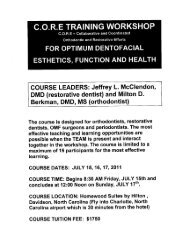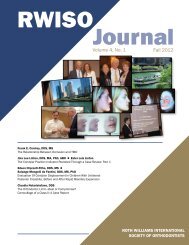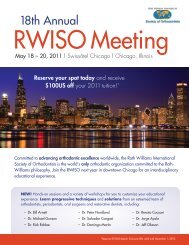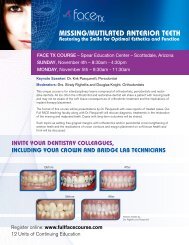2010 RWISO Journal - Roth Williams International Society of ...
2010 RWISO Journal - Roth Williams International Society of ...
2010 RWISO Journal - Roth Williams International Society of ...
Create successful ePaper yourself
Turn your PDF publications into a flip-book with our unique Google optimized e-Paper software.
Physiologic Treatment Goals in Orthodontics<br />
Andrew Girardot, DDS, FACD<br />
and R e W Gi R a R d o T , ddS, Facd<br />
ragfishing@hotmail.com<br />
■ Graduated from USC School <strong>of</strong><br />
Dentistry (DDS), 1968<br />
■ Graduated from USC School <strong>of</strong><br />
Dentistry, Dept. <strong>of</strong> Orthodontics<br />
(certificate in orthodontics), 1972<br />
■ Part-time Faculty University <strong>of</strong><br />
Colorado, School <strong>of</strong> Dentistry,<br />
Dept. <strong>of</strong> Orthodontics<br />
■ C<strong>of</strong>ounder, codirector and faculty,<br />
<strong>Roth</strong> <strong>Williams</strong> USA, 1997-present<br />
Introduction<br />
For the better part <strong>of</strong> a hundred years, orthodontists have<br />
used Angle’s classification as a means <strong>of</strong> communication.<br />
When we say “Class I,” orthodontists share the same image,<br />
which is generally a positive concept <strong>of</strong> how teeth should fit<br />
together. There certainly can be a Class I case with problems,<br />
but Class I is the first major step in describing optimal tooth<br />
relationships. To this day, Angle’s Class I describes a morphologic<br />
treatment goal for the orthodontic specialty.<br />
Why do we not have a similar physiologic treatment<br />
goal? Often we talk about “occlusion” in orthodontics, but<br />
it clearly means different things to different people. The term<br />
occlusion lacks the communication value <strong>of</strong> Class I. A “good<br />
occlusion” is a nebulous term that varies depending on the<br />
person using it. We have a communication problem. We enjoy<br />
general agreement, and hence communication clarity,<br />
regarding morphology, but this is not the case for physiology.<br />
It would certainly be <strong>of</strong> value to our patients and the<br />
orthodontic specialty if we had a clear definition <strong>of</strong> what<br />
constitutes optimal physiology or “good occlusion.”<br />
As in all biologic systems, the structural elements <strong>of</strong><br />
the human gnathic system have evolved to perform best un-<br />
Summary<br />
Angle’s class I has long served the orthodontic specialty as a morphologic<br />
treatment goal and a means <strong>of</strong> communication. Certainly a physiologic<br />
treatment goal would be <strong>of</strong> equal value. There are sound data to define and<br />
support such a physiologic goal, which can help orthodontists to better serve<br />
their patients, communicate with other dental pr<strong>of</strong>essionals, and avoid numerous<br />
clinical problems.<br />
der certain conditions <strong>of</strong> form and function. For example,<br />
there is considerable evidence to support a clear definition<br />
<strong>of</strong> healthy function for the temporomandibular joint in its<br />
loaded state, such as during a swallow. When loaded, the<br />
condyle should be positioned upward, forward and midsagittally.<br />
This definition <strong>of</strong> optimal joint position is agreed<br />
upon by most authorities1-15 and is well supported by the<br />
literature. 16-36 Okeson defines this as the “most musculoskeletally<br />
stable position <strong>of</strong> the mandible.” 7(112) There also are<br />
data indicating the optimal relationship <strong>of</strong> the condyle, disc,<br />
and eminence when the mandible is moving into or out <strong>of</strong><br />
the loaded position. In this condition, there should be constant<br />
contact between the condyle, disc, and eminence. 37-40<br />
There are numerous data indicating that neuromuscular<br />
function is highly influenced by tooth contacts and tooth positions.<br />
41-55 For example, as the mandible moves into and out<br />
<strong>of</strong> intercuspation, guidance from properly positioned anterior<br />
teeth aids in separating the posterior teeth. This reduces<br />
the activity <strong>of</strong> the powerful elevating muscles, which, in turn,<br />
downloads the system while facilitating constant contact between<br />
the condyle, disc, and eminence. 39,43,46,47,55-64<br />
Thus, current data point to an optimal physiologic rela-<br />
<strong>RWISO</strong> <strong>Journal</strong> | September <strong>2010</strong><br />
69








